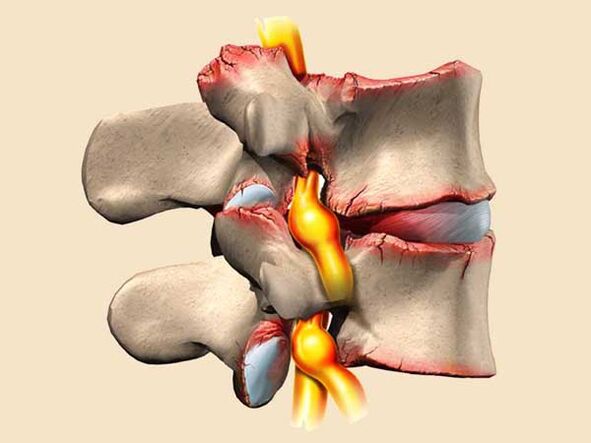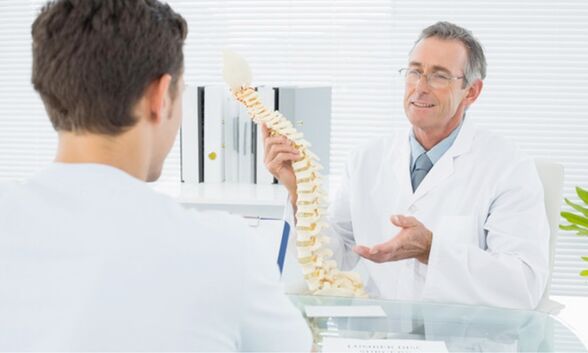Osteochondrosis of the thoracic spine (TOP) is a dystrophic degenerative change (destructive) in the function and condition of the intervertebral fibrocartilaginous formation (disc).
This disease, despite its high prevalence, is characterized by difficulty in detecting in the early stages of development, because the symptoms are similar to gastrointestinal diseases (peptic ulcer, gastritis, gastrological syndrome in colitis), angina pectoris and sometimes myocardial infarction.

Osteochondrosis of the thoracic spine is very difficult to diagnose.
Less commonly, this disease "disguises" as renal colic with cholecystitis or appendicitis. That is why you need to know the symptoms of osteochondrosis of the thoracic spine in order to correctly diagnose and start treatment on time.
How does osteochondrosis GOP develop?
In the human spine (more precisely, in the column) there are from 33 to 35 vertebrae, which are connected by an elastic disc, which consists of connective tissue and a nucleus.
Therefore, with the development of this disease (this is about 12 vertebrae), the connective tissue around the intervertebral disc is deformed first of all, because their elasticity is reduced.
As a result, the discs lose their strength and elasticity, which over time leads to one of two scenarios:
- disc rupture, as a result of which an intervertebral hernia appears;
- Spinal deformity + damage to individual vertebrae in the spinal column.

The second scenario is the result of the growth of growth bones along the edges of the spine, their deformation and thinning.
There are 4 degrees of deformation in osteochondrosis of the thoracic spine:
- Reducing the elasticity and height of the disc, protrusions may appear.
- Osteochondrosis of the 2nd degree of the thoracic spine is characterized by a further decrease in the elasticity and height of the disc, instability of the GOP. As a result, the appearance of neurological symptoms or hernia.
- Formation of intervertebral hernia.
- The disc loses its shock-absorbing properties. The spine, approaching, almost lost their mobility completely.
Cause of disease
The main reason for the development of this disease is considered to be aging, because according to statistics, symptoms of osteochondrosis of the thoracic region are found, as a rule, in people over 35 years old. What contributes to the deterioration of metabolism, "accumulation" of injuries and general wear and tear of the spine.
In other words, the older the patient, the higher the possibility of detecting signs of thoracic osteochondrosis in him.
But in fairness, it should be noted that recently more and more patients aged 19-30 years turn to neurologists with chest pain, which is increasingly diagnosed as a symptom of thoracic osteochondrosis. Doctors explain such dynamics with poor physical fitness, poor nutrition, curvature of the spine and flat feet. This violation is typical for people living in urban environments with "office" work.

Common causes of the development of thoracic osteochondrosis:
- spinal cord injury;
- genetic predisposition;
- immobility;
- overweight and smoking (metabolic disorders);
- prolonged exposure to wrong posture spine;
- excessive load;
- improper, poor nutrition (lack of fluids and trace elements);
- spinal load due to various diseases or wearing uncomfortable shoes;
- stressful conditions, nervous tension;
- violation of posture;
- diseases that lead to metabolic disorders.
Symptoms and signs of chondrosis of the chest
As already mentioned, sensations in thoracic osteochondrosis (symptoms) very often resemble other diseases, because they are less pronounced than in other types of this disease.
That is why it is very important not to engage in self-diagnosis, but to consult a qualified doctor in case of prolonged, periodic or "unexplained" pain in the thoracic spine.

Symptoms of osteochondrosis GOP:
- pain between the shoulder blades when bending over or lifting the arm up;
- pain between the ribs when walking;
- with thoracic osteochondrosis, it is difficult to breathe with increased pain during deep breathing or exhalation;
- feel the back and chest squeezed by the loop.
Chest pain in thoracic osteochondrosis appears:
- after or during a long stay in one position;
- slope;
- physical activity;
- exchange;
- at night.
Additional (special) symptoms of thoracic osteochondrosis, which can be covered as other diseases, especially in women:
- ringing and noise in the ears;
- frequent headaches;
- hoarseness and hoarseness;
- decrease in blood pressure;
- numbness of limbs;
- burning sensation in the chest, similar in sensation to heart pain in a heart attack, angina pectoris, or mammary gland pathology;
- in old age, frequent loss of consciousness;
- attacks of shortness of breath;
- constant tension of neck muscles;
- frequent hiccups

It should be noted that in women, the symptoms of GOP osteochondrosis are more pronounced, because their vertebrae are smaller and the connective tissue is thinner.
It is important to clarify that, contrary to popular belief, with osteochondrosis of the thoracic spine, the body temperature does not rise precisely because of this disease. However, it can increase due to the inflammatory process caused by GOP osteochondrosis.
Characteristics of pain
With osteochondrosis, pain in the sternum manifests itself as:
- Dorsalgia - mild, nagging, dull pain in the area of the damaged disc, which gradually increases and lasts up to 2-3 weeks;
- Dorsago is a strong, sharp, acute pain during an attack of thoracic osteochondrosis, which is also called "chest back pain. "
Diagnosis
Since osteochondrosis of the thoracic spine is less common than other types of this disease, and its symptoms are typical for other diseases, establishing the correct diagnosis sometimes takes a long time (trial and error). And only after excluding the most obvious options, doctors turn their attention to the symptoms of osteochondrosis.
Therefore, experts recommend contacting a medical institution specializing in problems with the musculoskeletal system in the event of the manifestation of characteristic pain sensations.

The diagnostic process itself takes place in 2 stages:
- Establishing the main diagnosis: examination and questioning of the patient. As a rule, this is done by a neurologist. Using special techniques, he examines the spine in various postures, rest and movement, paying attention to body structure, posture and sharp process lines. After identifying the signs of osteochondrosis GOP, a more detailed examination (finger) of the damaged area is carried out to determine the location and extent of the disease.
- Further, after the initial diagnosis, the patient is sent for a basic and more comprehensive examination of the thoracic spine: X-ray, CT and MRI.
How is osteochondrosis GOP treated?
Treatment is almost always carried out through conservative methods aimed at preventing the progression of the disease, eliminating pain, restoring spinal function.
If that doesn't work, then surgery has to be done.
Conservative treatment includes:
- physiotherapy;
- special diet;
- therapeutic restrictions;
- massage;
- drug therapy;
- manual techniques;
- spinal traction;
- reflexology;
- physiotherapy exercises (LFK).
Prevention
The method to prevent the occurrence of osteochondrosis GOP is very simple:
- avoid spinal hypothermia;
- avoid excessive load;
- frequent changes of posture during "office", sedentary work and breaks every hour for 5-10 minutes;
- morning exercise.



































